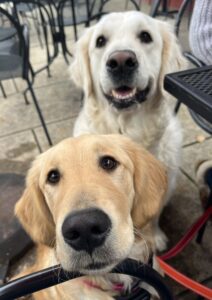
As a dog-lover and postpartum doula in North Jersey, I support many families who have an adorable four-legged, furry companion also waiting at home for baby. Some dogs arrived during the pandemic, or shortly thereafter, others have been around since the first joint apartment. A beloved pet who has followed you, and become attached to a life with two indulgent, loving, and attentive parents, will transition remarkably well to your baby with a little preparation. In fact, some couples express that they cannot imagine loving anything as much as they love their first best friend.
What can you, your friends, your doula, your in-laws or guests do to make transition happy for everyone in the home through deliberate preparation and love?
The advice or suggestions here are meant to kick-start your preparation, and are not meant to replace professional intervention from a dog behaviorist or trainer. This is especially valid if you have concerns about particular existing behaviors already. According to Aimee Hlushewsky, dog trainer extraordinaire in Bergen County, “The transition should start weeks before baby comes home…Set up baby gates, get him accustomed to going to his place for a yummy bone…Get him accustomed to the stroller, bassinet, etc.” Many parents are gifted items well in advance of baby’s arrival, so using your hatch to play white noise, or use your Bluetooth to play baby crying noise occasionally is easy. Consider putting out some pretty containers with dog cookies at your baby-changing stations, and within arms reach of where you plan to nurse your newborn.
In addition to preparing the physical space of your home, spend some time considering your dogs emotional preparedness. On average, dogs have an IQ of about 100, which does not reflect their skills in social situations and emotional intuition. Bring home a blanket that baby has used, so the dog can explore the new smell! Also, while you are away, trust your best friend to a care-provider who is reliable, one who will talk, cuddle, and care for your dog until you come back with your bundle. When you walk back in the door, consider allowing mom to go in without the baby to greet the dog. That pet really did miss her most. If possible, keep a high value treat tucked away for the first introduction, when baby is safely held and your pet approaches on his/her own terms. Aimee tells us, “Give your dog plenty of attention when the baby is around. You don’t want him/her to decide good things only happen when the baby isn’t around.”
If you have left out the stroller and car seat, stocked your home with dog-friendly goodies, and understand that your dog benefits from your pets, kind words, and walks, you are off to a great start! Having a baby at home means a level of exhaustion not likely experienced since finals-week in college. When your childless friends ask if they can help, hand them the leash and poop bags, with directions to the favorite dog spots in town! Provide the low-down on any quirks or surprise tugs they might experience, and then look forward to the return of a tired dog. Alternately, with the option of support from companies like Rover.com, you can experiment with different professionals prior to your due date without asking friends! While you pup may love doggy day-care, you may not be up for the drive right now. Find some support so your dog is not relegated to the crate 18 out of 24 hours.
Another thought about early postpartum weeks, is that new parents find out the dog toys and baby toys are similarly attractive to a dog. Given the fact that baby toys often have appealing smells, dogs will invariably swipe a few items that do not belong to them. Use smart training techniques when swapping out toys, trying not yell or express anger in the exchange, if a toy becomes accessible to Fido.
For some of us, dog licking is not a behavior we enjoy, never mind one to continue with your newborn. Just like we allow other trusted kids and adults to touch only baby feet, dogs can be discouraged from licking drooley mouths, runny noses or other attractive places on a baby’s face. For more tips, check out Dog Meets Baby. Another common boundary, is the nursery. If yours will be off-limits to the dog, practice that expectation throughout the room’s creation. Try using a baby gate in front the open door, allowing your pet to see you while safely keeping a distance.
After supporting a family as their birth doula, I look forward to spending a few hours a day or even overnight as a postpartum doula in their homes. Doula support is so helpful to parents as they adjust to life with a newborn because the care is inclusive – siblings, pets, grands, and besties.
One of my favorite canine clients, Ollie the St. Bernard, welcomed short walks outside her pretty little apartment, giving my clients’ one fewer task to handle! While I loved being Ollie’s doula too, she relished time with her grown-ups and new baby more. It was so much fun watching Ollie sit outside the baby’s contained safe area, as if protecting her newest charge.
One creative approach to making safe space for baby in smaller homes, is to devote a corner of the room to toys, bouncy seat, swing, or gym (I love the Lovery Play Gym) surrounded by gate to give the feel of baby’s first play yard. Add a comfy corner for yourself until baby is mobile, and everyone can enjoy being together.
Expectant parents who see the value in educated support before and after birth, deserve a doula! Visit my website, Judy White Doula to learn more about the ways a doula can support you, your baby and your pet. If you want a highly rated trainer for your young or young-at-heart four legged companion, check out AH Dog Training with Aimee.
